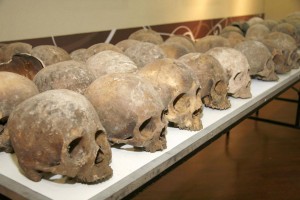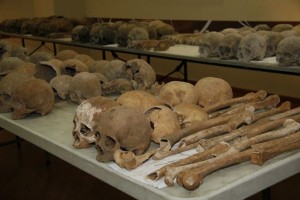 On Friday, March 9, a mass grave containing the remains of 167 people was found in a remote cave near the southern Mexican town of Frontera Comalapa. Local farmers had stumbled on the cave earlier in the week and alerted the Chiapas Attorney General’s office. Authorities located the cave on the Nuevo Ojo de Agua ranch and discovered piles of bones stacked on top of each other.
On Friday, March 9, a mass grave containing the remains of 167 people was found in a remote cave near the southern Mexican town of Frontera Comalapa. Local farmers had stumbled on the cave earlier in the week and alerted the Chiapas Attorney General’s office. Authorities located the cave on the Nuevo Ojo de Agua ranch and discovered piles of bones stacked on top of each other.
Over the past few years, Mexican authorities have found multiple mass graves containing victims of the brutal drug cartels. Approximately 50,000 people have died since 2006 from drug violence in Mexico. The cave is on a route frequented by Central American migrant workers traveling north, and migrants have been targets of mass slaughter by the cartels before, so police suspected the human remains were evidence of a contemporary crime.
Treating the cave like a crime scene, investigators removed the bones and brought them to the state capital of Tuxtla Gutiérrez where forensic experts tentatively estimated that the remains were about 50 years old. That put them outside the temporal range of drug cartels, but Frontera Comalapa is only 11 miles from the Guatemalan border, so investigators theorized that the dead were victims of the civil war that raged in Guatemala from 1960 to 1996.
 It was only then that the prosecutor’s office contacted the National Institute of Anthropology and History (INAH). INAH anthropologists examined the skeletal remains and found that they are not contemporary crime victims at all, but rather pre-Columbian and between 1000 and 1300 years old.
It was only then that the prosecutor’s office contacted the National Institute of Anthropology and History (INAH). INAH anthropologists examined the skeletal remains and found that they are not contemporary crime victims at all, but rather pre-Columbian and between 1000 and 1300 years old.
“The evidence that led us to determine the chronology was the practice of intentional cranial deformation,” [INAH anthropologist Javier Montes de Paz] said, who noted that the remains found at the site have the “tabular erect type of deformed skull.”
The Maya used planks to intentionally flatten and elongate the skulls of infants and the Maya are known to have used that cave for ceremonial purposes at various times, but we can’t say yet if the remains were Maya or another ancient pre-Columbian civilization. Some clay artifacts discovered in the cave might help shed light on who exactly these 167 people were.
Unfortunately the police weren’t thinking about preserving a potential archaeological site when they collected the bones, so essential historical clues have been lost.
“The archaeological context has already been altered and so obviously a lot of information has already been lost. All we can do now is go to the site, see how many of the artifacts were removed, how much damage was done to the archaeological context and remove as much as possible from the context that hasn’t been touched,” [INAH’s Emiliano Gallaga] added.
INAH experts have taken over the site now to excavate it thoroughly and will continue to analyze the human remains to determine the age, gender and cause of death.